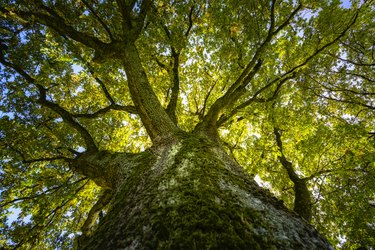
Other plants have insect-initiated growths known as galls, but oak trees (Quercus spp.) host more of them than any other plant species — more than 100 known types — that are hardy in U.S. Department of Agriculture zones 3 to 9, depending on the species. Created by the reaction between plant hormones and power growth-regulating chemicals produced by insects, white balls on an oak tree are galls are typically irregular tissue growths that occur on acorns, oak buds and leaves, stems, bark or roots.
Leaf and twig galls are the ones people notice most — cozy, protective homes for the protected larvae developing inside. The large, light-colored balls on oak trees are "oak apples," harmless galls that protect a single wasp larva inside.
Video of the Day
Video of the Day
Oak Apple Galls
If your tree has big white balls or light-colored balls, these are likely oak apple galls. Large, 1- to 3-inch apple-like growths that are hard to the touch, oak apple galls usually develop on the petioles — leaf stems — or midribs of oak leaves. Inside the spongy gall tissue is a single wasp larva protected by a hard seed-like cell.
By the time the gall "matures" and is dry and hard, the larva has become an adult and has made its exit. If you look closely at a dry oak apple you'll find the escape hole. As damaging as they may appear, oak apple galls don't harm trees.
Oak Tree With Balls
Most amusing of all galls is the pinhead-sized jumping oak gall found on — actually below — California's valley oak in summer, caused by a tiny cynipid wasp. Looking like tiny seeds, these minuscule galls "jump" around on the ground due to the tiny moving larvae inside. Eventually, the "seeds" stop jumping, as pupae develop. Tiny adult wasps later chew their way to freedom. The cycle starts all over again as female wasps lay their eggs on oak leaves to create new galls.
Roly-poly galls look something like hollow green grapes, each with a single seedlike wasp larva inside. Wool sower galls, seen in early summer on white oaks, look something like toasted marshmallows. But what looks like one gall is actually many, joined together on a twig, with seedlike larvae inside.
Harmful Oak Galls
Most potentially harmful are woody oak galls that form on twigs and stems, particularly the gouty oak gall and horned oak gall, which develop into masses that can girdle and kill branches or cause them to droop and crack due to sheer weight. Remove dead and damaged wood, which over time can distort the shape of a tree.
Treating Galls on Oak Trees
The fact that most galls are harmless means you don't need to do anything about them. Galls are well-protected habitats for associated insects during their most sedentary and vulnerable stage of development, so pesticide use and most other removal strategies don't work well anyway. For damaging gouty and horned oak galls, pruning away and destroying infested twigs as soon as they are noticed can reduce the associated wasp population in a limited geographic area.
Call in a qualified arborist for major infestations of highly valued trees. To control oak apple galls, remove and destroy them before they dry and adult wasps emerge. Similar strategies may work with other galls.